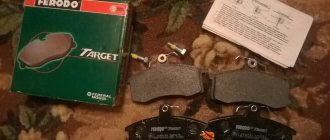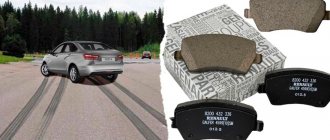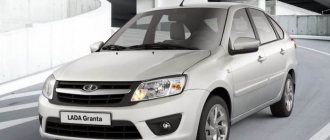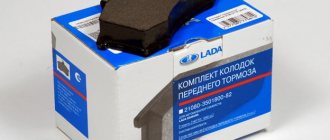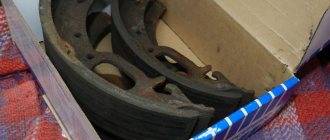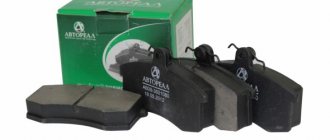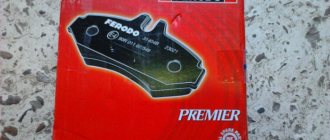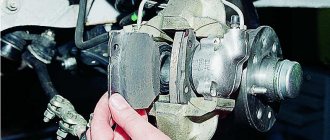1200 rub. for the photo report
We pay for photo reports on car repairs. Earnings from 10,000 rubles/month.
Write:
Lada Kalina cars of both generations have front disc brakes and rear drum brakes. As original front brake pads for Kalina 1, the catalogs indicate 21100-3501080-00 and 21100-3501080-01, for Lada Kalina 2 the article number is 11180-3501080-00. The same catalog numbers are used for Lada Priora.
Factory brake pads TIIR
Rear drum brake pads are specified as 21080-3502090-01 or 11180-3502090-10 (with ABS) for Kalina 1 and 2.
Many of these part numbers are invalid; instead, online parts stores offer other original part numbers or equivalents. This makes sense, since in the case of the Lada Kalina (and LADA in general), the original is often inferior in quality to its substitutes .
| Front disc brake pads Lada Kalina | ||
| With dimensions - length: 104.4 mm; width: 62.1 mm; thickness: 17. mm. | ||
| Manufacturer | Catalog number | *Price, rub.) |
| Brembo | P41003 | 780 |
| ** Ate | 13046029652 | 703 |
| Ferodo (Premier) | FDB527 | 640 |
| Hankook Frixa | FPE103 | 626 |
| NiBK | PN0223 | 536 |
| TRW | GDB469M | 495 |
| Ferodo (Target) | TAR527B | 405 |
| Lada | 21083501080 | 380 |
| Finwhale | V218 | 363 |
| Allied Nippon | ADB0173 | 330 |
The most popular brake pad analogues are Ate, Brembo, TRW, TSN, Finwhale and Ferodo. The latter are divided into two types according to the color of the box - “red” and “green”. “Green” ones, with the prefix Target in the name, are positioned by the manufacturer as an improved replacement for factory pads , but they are not intended for heavy loads. Red, with the prefix Premier, are considered premium pads that can withstand extreme loads.
The best-selling disc brake pads for Lada Kalina are products from Ate, followed by Brembo and TRW. Drum brake pads for Kalina are most often purchased from TSN due to its favorable price. They are slightly inferior in popularity to TRW and Ate pads.
| Rear drum brake pads Lada Kalina | ||
| With dimensions - diameter: 200 mm; width: 41 mm. | ||
| Manufacturer | Catalog number | Price, rub.) |
| Ferodo | FSB240 | 860 |
| Ate | 03013702312 | 815 |
| Sangsin | SA183 | 715 |
| TRW | GS8210 | 672 |
| Finwhale | VR318 | 658 |
| Bosch | 0986487813 | 610 |
| Profit | 50010240 | 650 |
| Allied Nippon | ABS1701 | 612 |
| Trialli | GF231 | 547 |
| TSN | 232 | 460 |
The brake pads indicated here are also suitable for other VAZ cars: 2110, 2114, Lada Granta and others, with R13 and R14 brake discs.
Front brake pads are replaced approximately twice as often as rear brake pads. The exact frequency of replacement is quite difficult to establish, but the front pads are changed at intervals of 30-50 thousand km, and the rear pads at intervals of 60-90 thousand. To more accurately determine when Lada Kalina brake pads need to be replaced, it is worth checking the thickness of the friction linings every 15,000 km. A thickness of about 2 mm is considered critical.
Drivers are often motivated to change brake pads on Kalina by squeaking brake pads. Special plates installed on the disc brake pads from the outside help significantly combat this. That's what they call them - anti-squeak plates . Such plates can often be found in more expensive brake pad sets. However, you should choose brake pads not based on the presence or absence of anti-squeak plates, but on the basis of reliability and braking efficiency.
Brake pads for Lada Kalina
The Lada Kalina, regardless of generation, uses front disc and rear drum brakes.
The process of stopping the machine is accompanied by wear of the pads, so they must be periodically replaced.
It’s easy to do it yourself, and if difficulties arise, it is recommended to watch a thematic video.
How to replace front pads
It is known that the disc mechanism consists of a brake disc and a caliper, and pads resembling flat plates in shape are attached to the latter. To replace the pads, the body is hung on a jack, the wheel is removed, and then the caliper fasteners are dismantled. This mount itself consists of two screws “1”, but only one of them (the top one) is unscrewed.
When the front brake pads are replaced, be it on a Lada Kalina or any other car, you need to change the entire set at once. It consists of four identical parts. This requirement cannot be violated (we only change the kit). Otherwise, the car will skid every time you brake.
The sequence of replacement actions is “recorded” in the photo. Each photo corresponds to one of the steps.
Replacing front pads VAZ-2192/2194
Article number and estimated cost of original front pads
The first generation Lada Kalina was equipped with brake disc pads with article numbers 21100-3501080-01 and 21100-3501080-00. Their price ranges from 460 to 500 rubles. The service life of the pads depends on the driving style and for most car owners it is 35-45 thousand km.
New brake pads have been developed for Lada Kalina 2. Their article number is 11180-3501080-00, and the price is 260-290 rubles. Consumables are not interchangeable with products for Kalina 1. Their service life can reach 60-70 thousand km, but usually replacement is required at 40 thousand km. The same pads are installed on the Lada Kalina Cross.
There are pads for Lada Kalina Sport. They are installed as tuning on standard cars, but this requires replacing the caliper. Consumables have improved performance characteristics.
Selection of pads and part numbers
Every Kalina car owner faces a difficult choice of spare part. What is better, original or analogue? After all, pads are the first link in traffic and braking safety. The answer lies on the surface. Both of them are quite good in quality and effect. But modern analogues are becoming even better, since the friction material of the majority is much better and more durable.
So, let's look at what front pads are suitable for the Lada Kalina.
Original pads
Let's start with the original part from AVTOVAZ. The catalog number of the part by which the search is performed looks like this - 2110-3501080. These are the same pads that are installed on the VAZ 2110 and Priora. The factory decided not to change the structure of the front brakes. Their cost is 400 rubles per set.
Analogs
Red Ferodos brake better, but it is believed that they eat up the brake disc a lot
Now, let's look at possible analogues that can be installed instead of the original brake pads on the Lada Kalina.
A table of analogues, as well as their catalog numbers and prices.
| Manufacturer's name | vendor code | Average price in the Russian Federation in rubles |
| Dafmi | D140IE | 390-450 |
| Master-Sport | 13-046D-2965-2-E-SET/4/-MS | 590-630 |
| Tomex | 10-361 | 600 |
| Mapco | 6502 | 620 |
| Pilenga | FD-P2003 | 850 |
| Trialli | PF965 | 850 |
| Fenox | BP40006O7 | 865 |
| Finwhale | V210 | 910 |
| Hola | BD811 | 950 |
| Optimal | 12075 | 978 |
| ABS | 37079 | 1070 |
| EGT | 322107EGT | 1150 |
| Denckermann | B111048 | 1165 |
| LRP | 05P988 | 1165 |
| Samko | 5SP988 | 1185 |
| LINXauto | BD-4601 | 1200 |
| FiT | FP0289 | 1320 |
| TRW | GDB1446 | 1350 |
| Road House | 2221.02 | 1350 |
| Icer | 181308 | 1360 |
| Brembo | P41003 | 1700 |
| Delphi | LP551 | 1765 |
| Girling | 6114461 | 2400 |
| Feredo "Premium" | FDB1325 | 3000 |
As you can see from the table, the choice of front brake pads for the Lada Kalina is quite wide and the owner will have plenty to choose from. Of course, the pricing policy for many analogues is too high, since compared to the originals at 400 rubles and the analogue at 2000 rubles. many people choose the original.
Non-original pads for Kalina, Nippon brand, very popular among Kalinovods
But, if you take Brembo, then the quality and service life of the pads are 2-3 times better, and the level of braking is 50% higher! (according to the results of independent tests). At the same time, they wear out 3-4 times slower, since they are made from higher quality material.
After replacing the brake pads, do not rush to leave. First, check the operation of the brake system. To do this, start the engine and press the brake pedal several times. After replacing the pads, especially if the brake fluid was taken from the reservoir, it is possible that the pedal will fail several times, but after that it should work normally.
Press the pedal 3-4 times, and if you feel that there is some resistance when pressing it, you can go out and check the results of your work. Please note that with new pads the braking will be sharper, so you will have to get used to the pedal.
Article number and price of recommended front brake pads for Kalina from third-party manufacturers
The brake pads installed from the factory have satisfactory quality and performance characteristics, so for replacement it is better to choose analogues from third-party manufacturers. The recommended non-original consumables listed below will ensure smooth and intense braking without any extraneous sounds.
Table - The best analogs of pads 21100-3501080-00 and 21100-3501080-01
| Manufacturer | vendor code | Estimated cost, ruble |
| Bosch | 986491700 | 1000-1200 |
| Remsa | 22100 | 450-700 |
| Road House | 222100 | 500-600 |
| Ferodo | FDB527 | 850-1000 |
| Delphi | LP551 | 660-800 |
Table - Good analogues 11180-3501080-00
| Manufacturer | Catalog number | Approximate cost, ruble |
| Profit | 50001325 | 540-650 |
| Road House | 222102 | 680-850 |
| TRW | GDB1446 | 1100-1300 |
| Ferodo | TAR527 | 540-620 |
| ATE | 13046029652 | 950-1100 |
Article number and approximate cost for rear original Kalina pads
Rear original drum pads for Lada Kalina of the first and second generation have article number 21080-3502090-01 in the case of the basic configuration. If the car is equipped with ABS, then the installed consumables come with catalog number 11180-3502090-10. The price of products ranges from 720 to 890 rubles. Replacement of pads is required every 70-90 thousand km.
Required Tools
To independently replace the stopping element on a Lada Kalina, a screwdriver and pliers are not enough. To perform the work, you need a full set of tools, which, as a rule, are in every garage:
- "balloon" key;
- wrenches 12, 7;
- slotted screwdriver
- 2x70 mm M8 bolts to press out the brake disc;
- a device for pumping brake fluid from the reservoir (syringe or bulb);
- container for drained brake fluid;
- hammer with rubber head;
- two mounts;
- special working fluid “VD-40”.
Replacement of rear pads on Lada Kalina is carried out only as a set on each side of the wheelset; they cannot be changed separately
Article number and cost of good analogs of original rear brake pads for Lada Kalina
When stopping, the rear axle does not bear the main braking force. Therefore, a more important characteristic for drum pads is their quietness. Original consumables cannot boast of the absence of squeaks and squeaks. Because of this, car owners prefer analogues from third-party brands, the best of which are listed below.
Table - Recommended analogues 21080-3502090-01
| Pad manufacturer | Article number | Approximate price, ruble |
| Bosch | 0 986 487 813 | 900-1200 |
| LYNXauto | BS-4601 | 1000-1400 |
| TRW | GS8210 | 1050-1300 |
| Remsa | 4129.00 | 1100-1600 |
| Textar | 91037201 | 1330-1800 |
Table - Recommended alternatives for 11180-3502090-10
| Pad manufacturer | Catalog number | Approximate price, ruble |
| TRW | GS8210 | 860-1000 |
| Finwhale | VR318 | 720-800 |
| ABS | 8812 | 670-780 |
| Bosch | 986487813 | 780-950 |
| Profit | 50010240 | 550-670 |
Advantages and disadvantages of drum brakes
Drum brakes are indispensable on trucks and buses, as they allow you to achieve the necessary braking force for heavy vehicles. The reasons for using them on the rear axle of passenger cars are somewhat different.
- Drum brakes simplify the design of the parking brake mechanism.
- They are less susceptible to wear due to the larger contact area between the friction linings and drums.
- Finally, they are less critical to road conditions, as they are reliably protected from dust and moisture getting inside.
Disadvantages of drum brakes include their slower response and less stability, which is a result of uneven contact between the friction lining and the drum. Another disadvantage of drum brakes is their more complex design. So how to check the condition of the rear brake pads?
Replacing front pads on Kalina
Instructions for replacing the front brake pads are given below.
- Jack up the car.
- Remove the front wheel.
- Turn the steering wheel to make it easier to replace the pads.
- Bend the locking plate.
- Insert a screwdriver and press in the brake piston. If this is not done at this stage, then later you will need to use a clamp.
- Unscrew the lower caliper bracket fastener.
- Open the caliper bracket.
- Remove old pads. If necessary, rearrange the anti-violin plates.
- Install the pads in their seats.
- Reassemble everything in the reverse order of removal.
- Check the operation of the brakes. A decrease in the intensity of stopping the car is associated with running in the pads
Front brake pad replacement process
Replacing front brake pads is a standard and not complicated operation on almost all cars. On the Lada Kalina, as on other cars of the VAZ series, this process takes 30-40 minutes and can be done with one pair of hands.
So, to replace the front brake pads of a Lada Kalina you will need the following tool:
- jack,
- pliers,
- wheel wrench,
- flat screwdriver,
- recoil guards,
- keys and heads.
Now that you have figured out the tools, you can get to work:
- We put the car on the parking brake, secure the wheels with wheel chocks and remove the front wheel. If possible, you can remove the second one.
- We turn the steering wheel in the direction we will work with.
- We bend the locking plate. In this case, pliers and a screwdriver will come to the rescue.
Everything is marked in the photo. We bend the locking plate using a flat screwdriver, unscrew the rest with keys 13 and 17
- Using the key “13” and “17” we unscrew the fixing bolt.
- We dismantle the caliper, or lift it up and hang it on the “wire”.
Raise the caliper using one bolt
- Recess the brake piston and remove the pads. You can use a balloon key.
We use a special device similar to a clamp
- To make installation and grinding easier, new pads can be lightly ground along the edges of the friction plate.
- Now, you can install new pads and put everything back together.
We install new pads. If you can’t put the caliper back on, it means you haven’t fully retracted the brake cylinder to its original position.
Thus, it is easy and simple to replace the front brake pads on the Lada Kalina.
Refinement of pads
To improve braking, you can install ProSport, Brembo or Vanx sports brake pads. But, to perform these manipulations, you will need to replace the brake drums and calipers, since the pads will not fit the standard sizes.
Read more about replacing rear brake pads on Lada Kalina here.
Brake pad set Lada SPORT
Also, if we are talking about modifications and tuning, it is worth installing soft pads that have 1 mm more friction surface. They perform better braking and wear out the brake disc less, but at the same time their service life is up to 15,000 km.
Step-by-step instructions for replacing rear pads
The algorithm for replacing rear drum pads is given below.
- Shift the gearbox to first speed.
- Remove the wheel by first jacking up the car.
- Unscrew the pins that secure the drum.
- Tap the back of the cover with a hammer using a wooden spacer. This will allow you to tear the drum out of place and remove it with loosening movements.
- Remove the cotter pin.
- Remove the lower spring that tightens the pads.
- Move the block to the side until the spacer bar leaves its seat.
- Remove the pads.
- Disconnect the handbrake lever and other parts. Replace everything with new consumables.
- Check the condition of the springs and, if necessary, replace them with new ones. To do this, you will need to purchase a special repair kit.
- Reassemble everything in the reverse order of disassembly.
- Check the brakes.
When to change the rear pads of LADA “Kalina”
The peculiarity of the LADA Kalina braking system is that when braking, the load is distributed unevenly and most of the kinetic energy is absorbed by the front brakes. Therefore, replacing the rear Kalina pads is done 2-3 times less often than the front ones. To find out when it’s time to change the pads, it’s useless to rely on the Kalina’s odometer readings. The number of kilometers a car travels between pad replacements can vary by half. The rate of their wear is influenced by many factors, some of which cannot be controlled and taken into account:
- driving style (during aggressive driving with frequent sharp acceleration and braking, the pads can wear out several times faster than during calm, smooth driving);
- quality of friction linings (counterfeits or pads from cheap brands last much less); the condition of the rear brake drums (if they have uneven wear or ellipticity, the wear rate of the pads increases greatly);
- exposure to external factors (chemicals that are sprinkled on the road surface in winter, other active substances that get on the friction linings).
Under normal conditions, the Kalina rear pads are replaced after 50-60 thousand kilometers. But you need to focus not on mileage, but on the thickness of the friction linings. If they are chipped, peeling, or become thinner than one and a half millimeters, they must be immediately replaced with new ones. Otherwise, damage to the brake drum or leakage of brake fluid may occur (if the linings are thin, the pistons may completely come out of the brake cylinders, which will cause depressurization of the circuit).
Entry three. Brakes.
In this post we will talk about rear brakes. Not long ago I began to notice that the rear brakes began to over-braking and make rustling sounds when braking. Over-braking the rear axle in icy conditions does not cause any positive emotions, and even more so if your wife is driving. Therefore, it was decided to quickly look for the cause. When I bought the car, I promised myself and everyone around me that in the near future I would only drive, and do only the most necessary things, without fanaticism. Yeah... Figurines. The poet’s soul couldn’t stand it... A plan was immediately born in my head about what needed to be changed. Absolutely everything was replaced except the hub itself and the handbrake cables. As they say, change is change :) On the first trip after buying the car, I had a strong feeling that it was time for the rear wheel bearings to retire. As a result, the list of necessary things included: 1. Rear wheel bearings 2. Rear brake pads (preferably ATE) 3. Rear brake cylinders (preferably ATE) 4. Brake drums (only factory and nothing else)
After going to the store, I was a little puzzled by the fact that the choice of brake pads for Viburnum with ABS is very small. To be more precise, only two companies. Either the factory or NIPPON. I came home and started smoking viburnum forum. And in fact, there is no choice. And the culprit is the ABS sensor, which is visible through the brake pad. Well, in the end I decided to buy NIPPON. I went to the store and bought: 1. Rear wheel bearings SS-20 At first impressions, the bearings left positive emotions. Beautifully packaged, nut as a gift, detailed installation instructions.
2. NIPPON rear brake pads. At first I thought the company was so-so. It turned out to be a Japanese company (well, of course I don’t know if it’s Japan, but something like that). I also liked how everything was packaged, everything was beautiful, napkin, instructions, etc.
3. Rear brake cylinders ATE.
4. Brake drums factory.
On the weekend I went to the garage and got to work. The process is the simplest, so there is no point in describing it.
During the analysis, it turned out that everything feels very good, nothing is leaking anywhere, nothing is rubbing, and everything is in its place, the pads are not even worn out. The only thing was that the cylinders were a little sour, but they worked fine. What was I doing for nothing? Everything can be replaced, without any dispute about who is to blame and who is not.
I quickly changed everything and put it in place
Next I took up the bearings. I pressed it out and pressed it in without much effort or difficulty. As usual, it couldn't be done without a sledgehammer. As my uncle said, “H... what can you do without a Russian sledgehammer”
I read a lot about bleeding ABS brakes. On the Kalina forum, opinions are very divided. I'll tell you from my own experience. I pumped it the old fashioned way. WITHOUT TURNING ON THE IGNITION AND ANY OTHER MANIPULATIONS! The only thing is that I pumped it not crosswise, but counterclockwise. Starting from rear right - front right - front left - rear left. Everything has been pumped up perfectly and is working. What can I say. The brakes have become wonderful. Brakes excellent, ABS works well, no extraneous noise or excessive braking. I achieved what I wanted, and I’m very pleased with the result. Oh yes, and now I don't hear the humming bearings, which is good :)
Rear brake pads PILENGA (with ABS) VAZ Kalina, Priora, Granta (set)
APPLICABILITY: VAZ 1117, 1118, 1119 (Lada-Kalina), VAZ 2170, 2171, 2172 (Lada-Priora), VAZ 2190, 2191 (Lada-Granta), VAZ 2192, 2194 (Lada-Kalina 2) with anti-lock braking system ( ABS).
founded in 1947 in the Italian city of Comun Nuovo, Bergamo. Pilenga ironworks produced plates for household irons. The crisis in the early 60s forced the company to consider other alternatives, and Pilenga began to develop a specialized workshop responsible for giving the finished shape of the brake disc. In the first years of its existence, Pilenga produced only castings for the needs of automobile factories. Pilenga production program consists of 35% of final products (brake discs and drums), and 65% of finished products (brake cylinder bodies, clutch pressure plates, pad frames, various gears, pins, rods, racks, etc.) for several dozen European manufacturers of spare parts.
Currently, Pilenga is the largest manufacturer of brake discs and drums for assembly lines of car factories in Europe and the USA (Chrysler and Harley Davidson). After a change in management, in 2000 Pilenga began supplying products to the aftermarket under its own name. Deliveries to Russia began only at the end of 2001.
The range of products produced under the Pilenga brand:
* brake and clutch master and slave cylinders * ball joints and steering ends * clutch kits * steering racks * wheel bearings * gearbox bearings * CV joints and drive assemblies * disc and drum brake pads * VAZ engine parts
All Pilenga fully comply with the quality standards adopted in the EU. Orders for Russian cars are made on the same equipment and using the same technology as orders from buyers from EU countries. Pilenga products manage to achieve competitive prices on the Russian market due to large sales volumes.
The company has its own research and development center, which is engaged in the development of formulations for alloys of non-ferrous and ferrous metals for the entire range of products. Much attention is paid to improving machining technology and control methods at all stages of production. In metallurgical production there is a computer system for controlling metal welding, which makes it possible to eliminate the slightest deviations from the given recipe. All products are manufactured on modern equipment using the latest advances in the field of metal production and processing. Modern 3D design technologies allow the brake disc development process to be carried out incredibly quickly, calculating the weight and dimensions that form the basis of the foundry phase of production. The number of items in the company's catalog is constantly growing, which is a consequence of the company's rapid adaptation to market requirements.
Pilenga produces about 200 types of clutch pressure plates. Over the past few years Pilenga has undergone many changes: the machining department has acquired a significant role and become an integral part of the foundry, quality control has become incredibly strict...
Just recently, Pilenga received an order to produce several hundred wheels for a Daewoo car, a very rare car in Italy for which the company had never produced wheels before.
Over 80% of the company's turnover is provided by exports. 90% of brake discs produced go abroad, on par with Germany, which occupies a leading position in this area. As for unprocessed cast iron billets, which account for 22-23% of turnover, the company has several foreign buyers.
Includes: 4 brake pads.
Which brake pads to choose
About a month ago I wrote a topic in which I shared the problem I had with the front brake pads.
The essence of this malfunction was as follows: when braking, even not sharply, a terrible creaking began to appear. Since I changed the linings quite recently, I thought that they were either rusty, since my Kalina practically did not drive in winter, or some kind of pebble hit, which was the source of this sound. But after looking more closely at the pads and discs, it became clear that there was no rust at all, and no foreign bodies either. Meanwhile, the creaking became stronger and stronger. I decided to remove the front wheel and take a closer look at what was wrong. As a result, it turned out that the pads were completely worn away, and on the inside they were completely worn down to metal, although I installed them only 8,000 km ago. Now I’ll tell you in more detail about how I chose brake pads for my Kalina and what I based them on.
What is needed to replace the rear pads of LADA “Kalina”
If you decide to replace the Kalina rear pads yourself, you will need:
- wheel wrench;
- jack;
- keys for 7 and 12;
- slotted screwdriver;
- metal brush; pliers;
- a pair of M8 bolts for pressing out the brake disc (bolt length is about 70 mm);
- brake fluid;
- a rubber bulb or syringe to remove some of the brake fluid from the reservoir;
- a small container into which you can drain the brake fluid;
- two mounts;
- rubber hammer;
- WD-40;
- set of new rear pads.
Attention: replacement of rear Kalina pads is carried out only as a set, two on the right and left sides. You should never change pads “one at a time” or only on one side!
Fake production, such as AvtoVAZ
As you probably already guessed, I drove just 8,000 kilometers on these pads, after which they turned into black dust left on the disks of my Kalina. I remember I picked them up at the car market for a price of about 230 rubles. And as the seller assured me, it was exactly the original from AvtoVAZ, which I, of course, later doubted, because my factory ones went about 30,000 km and weren’t even half worn out, but I’ll tell you why I replaced them a little later. So I don’t advise anyone to buy cheap ones, especially in the car market, otherwise, in the worst case, you might end up having to replace the brake discs.
Factory pads produced by AvtoVAZ
As for the service life, I have no complaints here at all, in this they completely suit me. Judge for yourself, they spent 30 thousand and could have served just as long. But there are huge complaints about the quality of braking; to put it mildly, there was none at all. I remember there were several cases when it was difficult to avoid a collision in city traffic. While I pressed the brake pedal with all my might, the car continued to float without noticeable slowdown. It was after several such cases that I decided to change it, but as it turned out, I ended up with a fake.
When the above options disappeared for reasons already known to you, I decided to wander through the forums of foreign car owners, and since I am a fan of the Volvo brand, I went to their club and read what kind of pads were on these cars from the factory. And according to many owners, their front and rear brake pads came from the factory from ATE. Well, I decided that if the safest cars in the world have such brakes, then they would also be an ideal option for Kalina. And now a few words about the impressions after installation. The first few kilometers, of course, there were no special changes, since they were still new and had not gotten used to it, but then everything became just super. Now, just before the speed bump, I brake and the car stops dead in its tracks, there are no sounds even close. As for efficiency, everything is just perfect here; I have not yet seen better brakes. But I can’t say anything about their service life yet, since I’ve only driven them a little over a thousand kilometers. And one more plus after installing them - the discs again became perfectly smooth, like new, otherwise they were corrugated from old defective parts, all in grooves. As soon as I drive the first 10,000 km on the ATE, I will definitely write about the results, subscribe and follow the blog updates. Thank you for your attention!
Replacing rear brake pads
- wheel wrench;
- jack;
- pliers;
- large slotted screwdriver;
- head at 7;
- rust remover liquid WD-40.
We place the car on a flat surface, fix the front wheels by engaging first gear and placing a “shoe” or brick under one of them.
- Using a wheel wrench, loosen the bolts securing the corresponding wheel.
- Use a jack to lift the car body from the desired side.
- Unscrew the wheel mounting bolts and remove the wheel.
- Using a 7mm head, unscrew the drum mounting studs (2 pcs);
- Remove the drum from the hub. If it does not give in, treat the drum seating area with anti-rust liquid (around the protective cap of the hub nut), and give it a little time to cool. After this, we try again and remove the drum.
- Using pliers, we bring together the antennae of the cotter pin that secures the pad tie. We remove the cotter pin from the rod by turning it a little.
- Using pliers, pull off the lower spring that tightens the pads on the right side and remove it.
- In the same way, remove the central springs of the brake pads.
- Holding one of the pads with your hands, move it slightly to the side and towards you until the plate under the upper spring moves away from the pad.
- We take out the plate and remove both pads.
- We install new pads in the reverse order, starting with installing the upper spring and the above-mentioned plate.
- It is important that when installing the new pads fit neatly into the grooves of the brake piston.
- We tighten the middle and lower springs using pliers.
- If the drum does not immediately seat on the new pads, press them on both sides with a screwdriver.
- Screw the drum mounting studs.
- Reinstall the wheel and tighten its mounting bolts.
- Lower the car body using a jack.
- Tighten the wheel bolts completely.
- Replace the rear brake pads on the other wheel in the same way.
Reviews of VAZ Kalina brake pads
I skated 66,000 km on original pads. At one point I heard a heartbreaking crunch of metal, I even had to stop. I unscrewed the wheel and looked at the disc, a little scuff appeared, well, everything is clear, the pads. I went to the store and bought an average price. I don’t even remember the price to be honest, but they completely suit me. They brake perfectly, and the most important thing is that they don’t creak.
- 2017-05-19
I’ve had Rosdot EURO 5000 since 2013 (by the way, who doesn’t know Rosdot is TIIR, I don’t remember just the 275 brand), I liked the pads, sometimes they creaked in traffic jams, then the creaking went away by itself, the brakes seemed strong, but I was wrong, during normal driving, everything seems to be fine until the moment you have to urgently release the brakes, this is where they show their abilities, unfortunately, sluggish... The front does not skid, the pads float, they are very disappointing in this regard, it is dangerous to drive with such brakes.
- 2016-03-31
After reading reviews and the Internet and not finding much crime, I decided to take RosDot, price 560 rubles. They look like they were made well, they look more attractive than the original with ugly varnish or whatever. Well, after 20 thousand I want to say that it’s not ice. At first it was fine. Then they started creaking like mad. And now there is some kind of incomprehensible ass with the rear brakes.
- 2016-03-03
I decided to change all the pads in a circle in order to slightly improve the brakes on my “Muscari Sport” and get rid of the beating during hard braking (apparently the pads were overheated or something else was wrong with them). The choice of pads is now very extensive: Ferado, FINWHALE, Dafmi, TRW, ALLIED NIPPON, Sangsin brake and even Brembo! But after reading a lot of reviews and based on the previous experience of my ex-2107, I settled on the already known LYNXauto. Somewhere I came across information that the pads are actually made from Japanese materials. I placed an order through an online store. The pads work just fine, the braking is excellent, they also brake in the rain without any problems, there is no squeaking! I will continue to install them.
- 2015-12-13
I took the risk of changing the pads to Finwhale. I've owned the car since 17k (I'm the second owner)... I changed it the other day. The odometer showed 22.7k. The choice in stores is of course great... from 240 to 900 rubles for a set of front ones. a spread of 8-10 different manufacturers... including Ferrodo. Ferodo didn’t take the risk - there are just a lot of fakes... The relatives (apparently factory ones) began to terribly irritate with their creaking... but that’s not so bad... for a mileage of 5k they sharpened the discs to 1mm... and the braking was reminiscent of a slight activation of the ABS: some small, but very frequent twitching... I installed Finwhale - I immediately went for a ride around the area and tried it while the roads were clear and pedestrians were not throwing themselves under my feet... I braked in different ways, quietly and to the floor until it came to a complete stop and the ABS was activated (I managed to hit the pedal once). The sensations (I have now driven 150 km on the new ones) are completely different. They brake softer and an order of magnitude more efficiently... You don’t have to put all your weight on the brake pedal (this is taking into account a normally working vacuum brake!) in order to stop without giving up. The creaking from the pads has practically disappeared (I'm tired of mowing under a UAZ). Barely audible sometimes. The creaking is very quiet and only appears during light braking at very low speeds (in a traffic jam, for example). The car stops softly, smoothly and very predictably. There is no need to strain your leg when braking and press the pedal even harder (on the old ones you seem to stop... but the speed is still reduced a little...).
- 2015-03-29
They brake well and almost do not creak, there is a slight squeak when you slow down slightly, but rarely. By the way, the pads have a groove in the middle.
- 2014-01-30
Finval pads are 129mm long, i.e. it turns out there is a gap of 1mm on the guide, which, according to the manufacturer of the brake mechanisms, can cause a knock when driving, so I bought Quattro Freni pads with a stated length of 130, they cost pennies, if you don’t mind. It's a shame, really. The length turned out to be 129.5, well, to hell with it, it still didn’t knock, my brakes just hit when braking hard, so I decided to experiment. It's a rare crap, when braking it began to hit even harder, even at low speeds, and they began to squeak, apparently it's a matter of heating, i.e. Budget pads don't do the job.
Brake pads for Kalina
Let's talk about the pads for the Lada Kalina car.
Of course, at the beginning I talked about the original version of the pads; for them there is a special catalog number by which they can be easily found:
21100-3501080-00 and 21100-3501080-01.
For the second article there is the following number: 11180-351080-00.
Using these numbers you can also purchase pads for the Lada Priora.
Let us immediately note that the owners do not speak very well of the original TIIR pads. You notice unpleasant sounds already at the beginning of use.
Rear brake pads have catalog number 21080-3502090 or 11180-3502090-10
Of course, in some online stores this data does not apply. Other numbers may be presented there.
Front disc brake pads Lada Kalina
| With dimensions - length: 104.4 mm; width: 62.1 mm; thickness: 17. mm. | ||
| Manufacturer | Catalog number | *Price, rub.) |
| Brembo | P41003 | 780 |
| **Ate | 13046029652 | 703 |
| Ferodo (Premier) | FDB527 | 640 |
| Hankook Frixa | FPE103 | 626 |
| NiBK | PN0223 | 536 |
| TRW | GDB469M | 495 |
| Ferodo (Target) | TAR527B | 405 |
| Lada | 21083501080 | 380 |
| Finwhale | V218 | 363 |
| Allied Nippon | ADB0173 | 330 |
Of course, there are analog brake pads that are no worse than the original ones. The most common companies are Ate, Brembo, TRW, TSN, Finwhale, Ferodo.
Finwhale, Ferodo - these manufacturers produce pads in two colors, red and green.
Green pads are not intended for heavy loads.
Red pads are considered premium class; they can withstand extremely heavy loads.
Of course, there are no comrades according to taste and color. Some people think that red ones are better, others think that green ones are better. But after conducting a survey, the Reds came out on top.
If we distribute and distribute places to pad manufacturers, then they will be distributed among themselves in this way:
Ate - 1st place, Brembо - 2nd place, TRW - 3rd place. If you want to save money, then pay attention to TSN.
Rear drum brake pads Lada Kalina
| With dimensions - diameter: 200 mm; width: 41 mm. | ||
| Manufacturer | Catalog number | Price, rub.) |
| Ferodo | FSB240 | 860 |
| Ate | 03013702312 | 815 |
| Sangsin | SA183 | 715 |
| TRW | GS8210 | 672 |
| Finwhale | VR318 | 658 |
| Bosch | 0986487813 | 610 |
| Profit | 50010240 | 650 |
| Allied Nippon | ABS1701 | 612 |
| Trialli | GF231 | 547 |
| TSN | 232 | 460 |
The pads shown in the photo above can also be used for VAZ 2120, 2114.
Please note that the front pads are changed much more often than the rear ones. Replacement of pads is approximately 50 thousand kilometers; for rear pads the period reaches 90 thousand kilometers.
We advise you to check the pads every 15 thousand kilometers. If suddenly your pads have reached a thickness of 2 millimeters, then you need to change them urgently.
Of course, it also happens that a creaking noise cannot be tolerated, so drivers often decide to replace them urgently. By the way, when installing new pads, it is recommended to install anti-squeak plates; they are installed on the outer side of the pads.
The plates often come with pads; of course, the price will be noticeably higher.
Choose the pads very carefully, look at the quality.
We change the pads correctly!
Replacing brake pads is not particularly difficult, but you need to pay special attention to safety.
To perform this procedure, you need to remove the wheel, and the car will be unstable under the jack. To avoid trouble, find a few bricks to place underneath after lifting the car. So, to replace these components on Kalina we will need:
- Balloon key.
- Head for 7 with a knob.
- Pliers (it is advisable to have long-nose pliers on hand, they are more convenient).
- Flathead screwdriver.
- 30mm socket with a wrench (can be useful if you have to remove the brake drum with bearing by twisting the hub).
Step-by-step instructions for replacing rear brake pads on a Lada Kalina car look like this:
- First of all, you need to put the car in gear, install the stops and lift the car with a jack. Then tighten the bolts and remove the wheel.
- After the wheel is removed, the drum studs should be unscrewed. For this we need a 7 head with a knob.
- Remove the brake drum. Underneath it, you need to find the cotter pin at the top and carefully remove it. Long nose pliers may come in handy here as the cotter pin is positioned awkwardly.
- Remove the lower spring. To do this, you need to pick up the fastener with pliers and pull it to the right.
- Remove the central retaining spring in the same way.
- After this, you can remove the right block. This can be done without even touching the upper spring; you just need to firmly grasp the block and pull it back, lifting it up until the fixing plate falls off.
- When the spring falls off, the pads are removed by hand. By disconnecting the central spring, you can also remove the left block with the handbrake lever.
- We replace the pads and reassemble in the reverse order.
In terms of time, replacing pads on one wheel takes about 1-1.5 hours, if you have all the necessary tools at hand. The procedure is quite simple, the main thing is to follow the step-by-step instructions, and then the replacement will be done quickly and easily.
If some points remain unclear to you, you can watch the video instructions for replacing these components. Remember, brake pads must be replaced on both wheels at once, then you will be able to achieve excellent braking in any situation.

